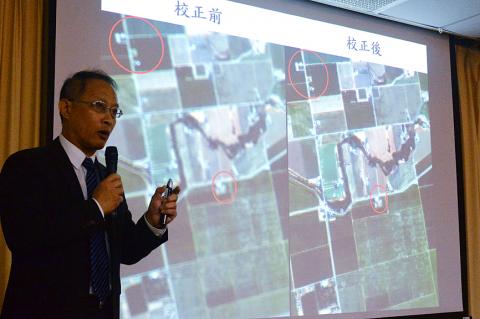Significant progress has been made in improving the imaging capabilities of Formosat-5, a National Space Organization (NSPO) official said yesterday, adding that the imagery can be used for disaster prevention.
Formosat-5, the nation’s first domestically developed satellite, was launched on Aug. 25 from Vandenberg Air Force Base in California. It was designed to deliver black-and-white images with 2m resolution and color images with 4m resolution.
While the images transmitted on Sept. 8 were blurry and tainted with light spots, NSPO officials denied there were any defects in any of the satellite’s components.

Photo: CNA
Later that month, the agency formed an advisory body of nine experts who offered advice on image adjustment and on identifying the cause of the imaging problem.
Images from Formosat-5 have achieved 5m resolution in color and 3m resolution in black and white when they are properly processed, NSPO Deputy Director-General Yu Shiann-jen (余憲政) told a news conference in Taipei.
While the images are sufficient for disaster prevention, urban planning and mapping would require greater resolution, he said.
Over the past three months, the agency has adopted three improvement measures: adjusting the temperature of the imaging facility, changing the altitude of the satellite and processing images through “deconvolution,” Yu said, adding that only the last measure worked well.
He illustrated the improvement by showing images taken by the satellite of Taipei, Nantou County, San Francisco International Airport and Davis-Monthan Air Force Base in Arizona, which were clearer than their counterparts from September.
The agency has collected more than 1,000 sets of images from the satellite, Yu said.
Davis-Monthan — best known for its so-called “boneyard” for decommissioned US government aircraft — has since the 1970s become the US military’s reference site to test aerial images, said National Chiao Tung University professor Shih Tien-yuan (史天元), a member of the advisory body.
While the root cause of the focus problem has yet to be confirmed, vibration during the satellite’s launch is one possible factor, National Central University professor Liang Chao-wen (梁肇文) said, adding that the design, composition and testing procedures of the satellite would be re-examined.
To make image processing more efficient, the agency plans to purchase new equipment with graphics processing unit systems next year, Yu said.
Asked whether the agency has a timetable for the problem to be completely fixed, Yu said it hopes to make images available to clients in August or September next year, while admitting that the time frame would be a two-month delay.

A magnitude 7.0 earthquake struck off Yilan at 11:05pm yesterday, the Central Weather Administration (CWA) said. The epicenter was located at sea, about 32.3km east of Yilan County Hall, at a depth of 72.8km, CWA data showed There were no immediate reports of damage. The intensity of the quake, which gauges the actual effect of a seismic event, measured 4 in Yilan County area on Taiwan’s seven-tier intensity scale, the data showed. It measured 4 in other parts of eastern, northern and central Taiwan as well as Tainan, and 3 in Kaohsiung and Pingtung County, and 2 in Lienchiang and Penghu counties and 1

FOREIGN INTERFERENCE: Beijing would likely intensify public opinion warfare in next year’s local elections to prevent Lai from getting re-elected, the ‘Yomiuri Shimbun’ said Internal documents from a Chinese artificial intelligence (AI) company indicated that China has been using the technology to intervene in foreign elections, including propaganda targeting Taiwan’s local elections next year and presidential elections in 2028, a Japanese newspaper reported yesterday. The Institute of National Security of Vanderbilt University obtained nearly 400 pages of documents from GoLaxy, a company with ties to the Chinese government, and found evidence that it had apparently deployed sophisticated, AI-driven propaganda campaigns in Hong Kong and Taiwan to shape public opinion, the Yomiuri Shimbun reported. GoLaxy provides insights, situation analysis and public opinion-shaping technology by conducting network surveillance

Taiwan is gearing up to celebrate the New Year at events across the country, headlined by the annual countdown and Taipei 101 fireworks display at midnight. Many of the events are to be livesteamed online. See below for lineups and links: Taipei Taipei’s New Year’s Party 2026 is to begin at 7pm and run until 1am, with the theme “Sailing to the Future.” South Korean girl group KARA is headlining the concert at Taipei City Hall Plaza, with additional performances by Amber An (安心亞), Nick Chou (周湯豪), hip-hop trio Nine One One (玖壹壹), Bii (畢書盡), girl group Genblue (幻藍小熊) and more. The festivities are to

Auckland rang in 2026 with a downtown fireworks display launched from New Zealand’s tallest structure, Sky Tower, making it the first major city to greet the new year at a celebration dampened by rain, while crowds in Taipei braved the elements to watch Taipei 101’s display. South Pacific countries are the first to bid farewell to 2025. Clocks struck midnight in Auckland, with a population of 1.7 million, 18 hours before the famous ball was to drop in New York’s Times Square. The five-minute display involved 3,500 fireworks launched from the 240m Sky Tower. Smaller community events were canceled across New Zealand’s